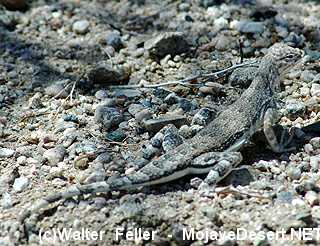Zebra-tailed Lizard
Callisaurus draconoides
Family: Phrynosomatidae Order: Squamata Class: Reptilia
DISTRIBUTION, ABUNDANCE, AND SEASONALITY
The zebra-tailed lizard is common and widely distributed throughout the Mojave, Sonoran
and Colorado deserts and its range extends north into the southern Great Basin. Found at
elevations up to 1520 m (5000 ft) (Macey and Papenfuss 1991). Frequents sandy and gravelly
desert flats,
washes
and alluvial plains in a variety of
desert woodland
and
desert scrub habitats.
Occasionally occurs in rocky areas, but seems to prefer flats dominated by scrub vegetation.
Commonly found along the margins of
dunes
however seems not to prefer extensively sandy
habitats (Stebbins 1954, Pianka and Parker 1972, Tanner and Krogh 1975). In areas of
creosote scrub,
this lizard appears to reach highest densities, 12-15 per ha (4.8-6.0 per ac)
(Tanner and Krogh 1975). This lizard appears early in the spring, usually by mid-March
near California City, and is active in decreasing numbers through early fall.
SPECIFIC HABITAT REQUIREMENTS
Feeding:
Food consists of arthropods such as beetles, grasshoppers, crickets, flies,
ants, bees, wasps, moths, and spiders (Stebbins 1954). Often this lizard jumps several
body-lengths off the ground to capture flying insects. Occasionally lizards
(Coleonyx variegatus
and
Uta stansburiana)
and the fruiting heads of plants are taken (Stebbins
1954).
Cover:
This lizard burrows into fine sand for retreat at night and usually seeks day
shelter in the shade of bushes.
Reproduction:
Eggs are laid, presumably in friable, sandy soil.
Water:
Probably not required.
Pattern:
The zebra-tailed lizard is a fast-running, insectivorous inhabitant of desert
flats, washes and plains. It seems to prefer areas with moderate to sparse densities
of vegetation and rocks, which impede rapid locomotion for predator avoidance and
prey capture.
SPECIES LIFE HISTORY
Activity Patterns:
This lizard is
diurnal,
rising early, usually before other species, and
remaining active throughout the day in all but the hottest weather. During the hottest
times of day, lizards may stand alternately on two legs in the shade of bushes or climb into
the bushes to avoid the heat of the substrate. This species is one of the first to emerge in
the spring, usually by mid-March near
California City,
and remains active through the
summer.
Seasonal Movements/Migration:
This species is not known to migrate.
Home Range:
Home range depends on season, sex, and habitat and has not been
well studied. In creosote scrub in Nevada, home ranges varied from 0.35-0.60 ha
(0.88-1.50 ac) (Tanner and Krogh 1975).
Territory:
This species has an elaborate social system with visual and olfactory
forms of communication. Males behave aggressively at times, but home ranges overlap
broadly and it is not known if these territories are defended.
Reproduction:
In
Joshua Tree National Park,
eggs are probably laid in June
(Miller and Stebbins 1964). This lizard lays an average of 4 eggs per clutch (range 2-6),
and may lay as many as 5 clutches in years with greater than average rainfall (Stebbins
1954, Fitch 1970).
Niche:
This species is preyed upon by
carnivorous lizards
(Gambelia
and
Crotaphytus),
snakes
(Crotalus cerastes,
Masticophis,
etc.), avian predators
(logger-head shrikes)
and probably mammalian predators. It has a very high reproductive potential in the face of
this heavy
predation.
Greater than average rainfall usually results in the production of
more clutches of eggs (Fitch 1970)
Fitch, H. S. 1970. Reproductive cycles in lizards and snakes. Univ. Kans. Mus. Nat. Hist. Misc. Publ. 52:1-247. Macey, J. R. and T. J. Papenfuss. 1991. Reptiles. Pages 291-360 in C.A. Hall, Jr., editor. Natural History of the White-Inyo Range eastern California. Univ. Calif. Press, Berkeley, California. 536 pp.
Miller, A. H., and R. C. Stebbins. 1964. The lives of desert animals in Joshua Tree National Monument. Univ. California Press, Berkeley. 452pp.
Pianka, E. R., and W. S. Parker. 1972. Ecology of the iguanid lizard Callisaurus draconoides. Copeia 1972:493-508.
Stebbins, R. C. 1954. Amphibians and reptiles of western North America. McGraw-Hill, New York. 536pp.
Tanner. W. W., and J. E. Krogh. 1975. Ecology of the zebra-tailed lizard Callisaurus draconoides at the Nevada Test Site. Herpetologica 31:302-316.
California Department of Fish and Game. California Interagency Wildlife Task Group. 2005. California Wildlife Habitat Relationships version 8.1 personal computer program. Sacramento, California.
 Zebra-Tailed Lizard
Zebra-Tailed LizardCallisaurus draconoides
These very fast lizards are easily identified by their black stripped "zebra tail." When agitated the lizards wave their very prominent tail, and it is thought that this provides protection. When predators go after a Zebra-Tail they often see the tail, so this is the point of attack. If that is the body part they grab it simply falls off, and the lizard escapes having lost a tail but not its life. You can often get surprisingly close to a Zebra-tailed Lizard. They will stand high on their legs as you approach, sometimes doing a couple of "push-ups" with their front legs. But when you finally are close enough to scare them off, they dash away with a blur. Look for them in sandy washes.
> Zebra-tailed Lizard Picture Slideshow <
Additional notes:
Size: 2.5-4 in (6.2-10 cm)
Distinguishing characters: A long legged species with a flat tail; dark bands on underside of white tail and black belly markings at or anterior to midpoint of body; granular dorsal scales; gular fold; diagonal furrows separating upperlabials; grey dorsum with dusky markings, yellow on sides; light venter with pinkish or orange spot on throat.
Juveniles: Similar to adults.
Dimorphism: Male has enlarged postanal scales and more prominent belly markings.
Similar species: Phrynosoma coronatum: Only other lizard with flat tail, but has spines on head and body. Uta stansburiana: Lacks the dark bars under tail, and has blue-black side blotch.
Quick runner, and will raise and wave tail when confronted and ready to escape.